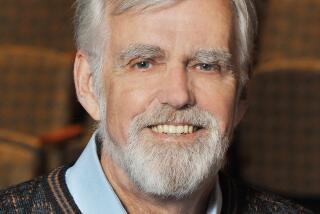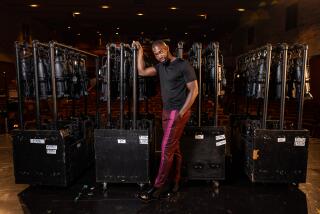FINAL FADEOUT FOR NOSSECK THEATER
- Share via
Only two days after the Cock ‘n Bull announced its closing after half a century, its neighbor, the Nosseck Theater, announced that it would close Monday.
It’s the small screening room tucked away in the basement of the David Geffen Building at the corner of Sunset and Carol. It’s unknown to the general public, but it was almost as much a Hollywood landmark as the restaurant.
In its early days, Garbo and Chaplin were regulars and Howard Hughes once holed up there for three solid months. Sam Arkoff and the late James Nicholson practically used Nosseck’s as their office when they were launching their American International Pictures. Those of us who have been reviewing movies for a long time have been there countless times.
Nosseck’s was always said to be the first independent screening room in Hollywood, and, when Martin Nosseck left his job as a studio projectionist at Columbia Pictures to go into business for himself in the early 1940s, he had to defy union pickets when he turned a private screening room into rental facility. Nosseck, who died in November, 1981, in his late 70s, was the brother of Max Nosseck, director of the original “Dillinger,” which starred Lawrence Tierney. Martin had two sons, Noel, the director, and Don, who ran the screening room until his own untimely death at 55 in February. Since then Don’s widow Marilyn has been running the room, and, when Geffen served her with an eviction notice, she decided to call it a day sooner.
Even though Nosseck’s was followed by fancier screening rooms, it was always a pleasure to go there. Martin Nosseck was the most genial, avuncular of hosts. He was a short, stocky man with a guttural accent, much warmth and a fund of Hollywood stories. No interior decorator ever had a go at the theater with its small reception room and cluttered office, but it was always clean and homey. It looked the same, only a bit fresher, after having been rebuilt after a fire in the ‘70s.
In the reception room there was a big couch (sometimes employed as a bed by struggling film makers), a pile of trade papers on a table and always a pot of fresh coffee.
Martin, and later Don, never minded you using the phone to check for messages--as long as you used the red one.
On the wall of Martin’s office was a formal portrait of his late wife Hilda, a photograph of an elegant 19th-Century European town house, which had been the Nosseck family home, lots of snapshots of children and grandchildren, and a number of posters of obscure kiddie movies in which Nosseck was involved in distributing. Nosseck appreciated good movies and was depressed when porno film makers rented his facilities.
“Martin lived for the industry, it was his whole life,” recalled his daughter-in-law Marilyn. “Martin and Max came to United States from Berlin, but they came separately. Martin had to go to Jamaica in a fruit boat and then somehow sneaked into the country and became a projectionist in New York. I’m sure Max, who was already a famous director in Europe, came royally--that was always his style.”
More to Read
The biggest entertainment stories
Get our big stories about Hollywood, film, television, music, arts, culture and more right in your inbox as soon as they publish.
You may occasionally receive promotional content from the Los Angeles Times.










